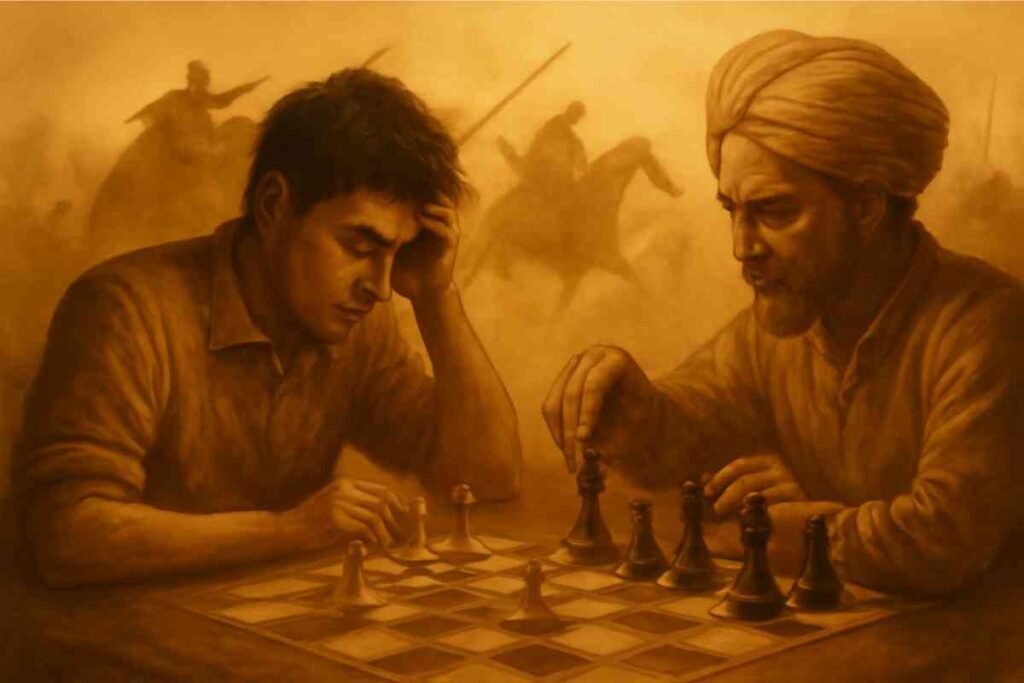On a quiet, checkered board of 64 squares, two minds clash in a silent, intense battle. A king is trapped, an army decimated, a kingdom falls. This is chess, the universal game of strategy. But long before it became a global intellectual sport, its ancestor was born on the soil of ancient India, not just as a pastime, but as something far more profound: a sophisticated and bloodless war game, a cerebral battlefield named Chaturanga.
While other civilizations honed the spear and sword, ancient Indian thinkers were also busy honing the mind as the ultimate weapon. They conceived of a way to simulate battle, test tactics, and train generals without a single drop of blood being shed. Chaturanga wasn’t just a game; it was a revolutionary approach to conflict, a strategic laboratory that reflected a deep cultural preference for intellect over brute force. It was, in essence, India’s invention of war without war, where the only casualty was your opponent’s smug grin.
The Four Limbs of an Army on a Board
The very name Chaturanga reveals its purpose. In Sanskrit, it means “four limbs” or “four divisions,” directly mirroring the four-pronged structure of a classical Indian army:
- Padati (Infantry): The foot soldiers, represented by the pawns. Numerous, seemingly expendable, but capable of advancing to achieve great power.
- Ashva (Cavalry): The horse-mounted warriors, whose unique L-shaped movement mimicked the cavalry’s ability to leap over obstacles and outflank enemies. The original knight in shining armour.
- Gaja (Elephants): The mighty war elephants, the tanks of the ancient world. Their movement (diagonally, in most early versions) represented their powerful but sometimes linear charge.
- Ratha (Chariots): The swift, straight-moving chariots that controlled the flanks, capable of devastating charges along open ranks.
At the heart of this force were the Raja (the King), the ultimate objective, and his Mantri (the Advisor or General), his most powerful, versatile piece. Sound familiar? This wasn’t abstract fantasy; it was a direct, playable model of a real-world Indian military force.

A Laboratory for Strategy, A Haven from Violence
Why go to all this trouble to create a simulation? The answer lies in a unique Indian approach to conflict:
- Valuing Intellect over Violence: While ancient India certainly had its share of wars, its philosophical traditions (seen in texts ranging from parts of the Mahabharata to treatises on statecraft) placed immense value on strategy (niti), diplomacy, and out-thinking an opponent. Brute force was often seen as a less refined last resort. Chaturanga was the ultimate intellectual akhara (wrestling pit) for commanders.
- The Original ‘Beta Test’ for Battle Plans: Imagine a king and his general contemplating a risky pincer movement. Instead of sacrificing thousands of soldiers to see if it works, they could test the theory on the Chaturanga board. It was a safe space for tactical experimentation, allowing for the rehearsal of strategies, the understanding of defensive formations, and the consequences of a tactical blunder, all before the first real arrow was loosed. A checkmate on the board was infinitely better than a catastrophe on the battlefield.
- Training Strategic Minds: The game wasn’t just for kings. It was an educational tool, teaching players vital skills applicable to war and life: foresight, patience, resource management (don’t needlessly sacrifice your elephants!), understanding an opponent’s psychology, and the critical importance of protecting the leadership (the King).
Getting checkmated over a cup of chai was a humbling, but ultimately harmless, way to learn a brutal lesson.
The Journey from ‘Raja’ to ‘Checkmate’
This brilliant Indian invention didn’t stay put. As trade and cultural exchange flourished, Chaturanga traveled westward.
- It reached Persia, where it was adopted with great enthusiasm and became known as Shatranj. The pieces and rules were slightly adapted. The name for the king, Shah, became central.
- From Persia, it entered the Arab world, where the phrase “Shah Mat” (“the king is finished/helpless”) was used to declare victory.
- The game then travelled with the Moors into Europe, where it was adapted over centuries. The Mantri transformed into the far more powerful Queen, the Gaja (elephant) eventually became the Bishop, and the Ratha (chariot) became the Rook.
- And the victorious cry of “Shah Mat”? It morphed through various European languages into the word we know today: Checkmate.
Every time a player anywhere in the world utters that final, decisive word, they are unknowingly speaking a phrase with Persian roots, referring to a king from a game born in ancient India.
The Enduring Legacy: A War of Wits
The legacy of Chaturanga is more than just the modern game of chess. It represents a profound cultural mindset – a belief that the greatest battles are often won not by the strongest arm, but by the sharpest mind. It’s a testament to a civilization that saw value in creating a “war without blood,” a tradition that preferred the clash of intellects to the clash of swords.
This spirit of strategic, non-violent competition resonates in India even today, from its diplomatic postures on the world stage to the intellectual rigour of its tech innovators. The ancient game board was India’s original startup incubator, fostering the kind of strategic thinking that continues to shape its journey.
What does the game of chess mean to you? Can you see its origins as a battle simulation in how you play? Share your thoughts in the comments below! If this piece checkmated your assumptions about chess, please share it on WhatsApp, Facebook, and Twitter!